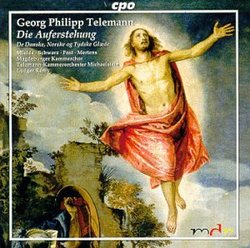| All Artists: Lothar Hennig, Ludger Remy, Dorothee Mields, Britta Schwarz, Andreas Post, Klaus Mertens, Reinhard Decker, Magdeburg Chamber Choir, Telemann Chamber Orchestra Of Michaelstein Title: Telemann: Die Auferstehung (The Resurrection), De Danske, Norske Og Tydske / Magdeburger Kammerchor, Mields, Schwarz, et al Members Wishing: 0 Total Copies: 0 Label: Cpo Records Release Date: 6/22/1999 Genre: Classical Styles: Opera & Classical Vocal, Historical Periods, Baroque (c.1600-1750), Symphonies Number of Discs: 1 SwapaCD Credits: 1 UPC: 761203963423 |
Search - Lothar Hennig, Ludger Remy, Dorothee Mields :: Telemann: Die Auferstehung (The Resurrection), De Danske, Norske Og Tydske / Magdeburger Kammerchor, Mields, Schwarz, et al
CD Details |
CD ReviewsGerman oratorio and Danish cantata 07/12/1999 (4 out of 5 stars) "This CD in the CPO label's ongoing rediscovery of Telemann's vocal music includes two 30 minute pieces: The first is a Resurrection oratorio (Die Auferstehung TWV6:7) from 1761 and the second a real rarity commissioned from Telemann by the Kingdom of Denmark in 1757 to a Danish text with a Latin coda (De Danske, Norske og Tydske Underssates Glaede TWV12:10). It has to be said that the cantata is a bit of a novelty, and one detects that Telemann found his lack of Danish inhibited any word painting, but it is still quality Telemann, and the German oratorio is truly lovely in its own right.As usual with CPO presentation is excellent, and includes both texts in German, Danish/Latin and English translations." Oddly recorded G. Metcalf | United States | 03/16/2006 (4 out of 5 stars) "I suppose this excellent CD was recorded in a very large space. That is at least how it sounds. It starts out almost inaudibly with a solo bit that sounds fairly distant then ... BOOM the orchestra fires up and the bass particularly is loud by comparison. Once I got used to the sonic level I noticed that the orchestra is substantially more distant than the vocal soloists. That's all the criticism I can offer however. THese compositions are excellent baroque oratorios and the musical detail is nicely captured. The singers -- particularly the soprano soloists -- are beautiful." The Musical Harrowing of Hell Giordano Bruno | Wherever I am, I am. | 08/29/2009 (5 out of 5 stars) "Ignore the tepid ratings of the two previous reviewers! Forget the common perception of Telemann as a charming lightweight. The Resurrection cantata recorded here is superb, distinctive music, a bridge between Bach and Haydn with the best of both combined coherently. At times Telemann is so effortlessly masterful that his innovations sound like "just what we expected", and that's the case in Die Auferstehung, which Telemann composed in 1761, his 80th year of life, not as a liturgical work but as a concert setting of a poem by his colleague Friedrich Wilhelm Zachariae. Thus Telemann was paralleling the path of Handel, from opera to commercial oratorio, in the far more conservative milieu of Lutheran Germany. Drama is everything in this cantata, from the hushed vocal/instrumental lament at the Tomb with which it begins, to the frenzied depiction of the harrowing of Hell by the angry Messiah, to the hesitant and then triumphant proclamation of resurrection for all the faithful at the End of Days. I'm not the first listener to suggest that Telemann's Auferstehung foreshadows Haydn's Creation Oratorio by several decades, but frankly I'll go a little farther; Telemann's work has more energy and originality in roughly a quarter the number of measures. Die Auferstehung is a work of theatrical contrasts, not only of mood but of musical dynamics, beginning with spare pianissimo arpeggios and the plaintive murmurs of Mary Magdalene at the Tomb following by the stunning eruption of tympani and trumpets with the announcement that the tomb is empty. Such acoustic drama is another marker of Telemann's innovative intentions, his transformation of a genre previously bound by the decorous solemnity of congregational worhsip into a public, audience-pleasing aesthetic. The dynamic range from pianissimo to fortissimo, however, means that you won't be able to appreciate this CD on your car stereo or while you're trying to pay your utility bills; it demands and compels concert-hall attention.
Sacrificial atonement, expectation of a messiah, final judgment are almost universal elements of Indo-European and Semitic mythologies, and as such can have intense emotional appeal even to a confirmed unbeliever. Telemann, Bach, and Zelenka all have the musical universality to arouse such emotions, whether one attends to the words and lessons of their texts or not. Telemann was highly selective of his texts, both for their spiritual substance and their literary excellence. This `musical poem' is indeed a fine sample of German Baroque spiritual poetry. Nevertheless, it comes as a relief that the second cantata on this CD is utterly secular. The text of "De Danske, Norske og Tydske Undersaaters Glæde" is tri-lingual, in Danish, German, and Latin. It was commissioned for the celebration of the Danish King Frederick V's birthday in 1757. held at the Christianeum, a royally endowed Latin school in Altona, a town then under Danish rule near Hamburg. Telemann was an instructor of music at the Christianeum and was thus cautiously familiar with the limited musical skills available there. Always committed to satisfying the demands of his patrons and audience, Telemann offered the King a lovely, pastoral birthday card, sweetly innocent and tuneful, using chiefly the voice of a skilled soprano hired from Hamburg. With limited resources, in a composition intended for a single performance, and with a text consisting of fulsome flattery, Teelmann wrote music that is, I think, universally enjoyable. The performance of these two very different cantatas, conducted by Ludger Rémy with the large Kammerorchester Michaelstein, is worthy of the music in every way. I've also recently reviewed a recording of Telemann's cantata "Zerschmettert die Götzen", a superlative performance by the Accademia Daniel." |


 Track Listings (34) - Disc #1
Track Listings (34) - Disc #1